Today Hero Collector releases Star Trek – A Celebration, their new book looking at the making of Star Trek: The Original Series. We previewed the book last month and today we have an exclusive chapter all about the iconic phaser rifle designed by legendary game designer Reuben Klamer, who passed away last week.
A message from the co-author
Co-author Ian Spelling had this to say about the chapter and Reuben Klamer:
“The story of the phaser rifle fascinated me and I wanted to be sure we included it in TOS – A Celebration. Mr. Klamer’s prop really and truly helped convince NBC that Star Trek could deliver action in addition to thought-provoking ideas, and so they gambled on picking up the show. Then, the prop was never seen again on the show and it seemed to disappear in a real-world context as well. Mr. Klamer had it for decades, and he sold it at auction for a small fortune a few years ago. It took me several weeks of old-school sleuthing to track him down earlier this year. He was in ill health, but on a good day a few months back his assistant called and said he could speak to me. We chatted right then and there. If this isn’t the last interview that Mr. Klamer gave, it’s one of the last, and I’m so grateful that we got him and could let him comment on his place in the Star Trek phenomenon.”
Excerpt from Star Trek – A Celebration
T H E P H A S E R R I F L E
After its appearance in the second pilot, one of STAR TREK’s most memorable props disappeared from view for the best part of 60 years.
Gene Roddenberry, Matt Jefferies, and Wah Chang get the lion’s share of credit for creating the look of STAR TREK and inventing its iconic props. However, there’s another crucial figure, a man rarely mentioned in the same breath as the headliners above, who merits recognition. That man is Reuben Klamer.
In 1965, Klamer designed/created the phaser rifle that Kirk wielded in the second STAR TREK pilot, ‘Where No Man Has Gone Before.’ Kirk utilized it to weaken his god-like old friend, Gary Mitchell, and then to topple boulders that buried Mitchell in a grave meant for Kirk. The episode’s action – exemplified and amplified by the phaser rifle – helped nudge NBC to commit to STAR TREK as a series. Also, in 1966, a few months before STAR TREK premiered, network publicists arranged a photoshoot with Shatner, Nimoy, Grace Lee Whitney, and unwittingly, the phaser rifle. The resultant images stoked viewer anticipation about the upcoming sci-fi series – and triggered a mystery.
After ‘Where No Man Has Gone Before,’ the weapon disappeared from the show. The prop itself seemed to vanish, too, until it went under the gavel in 2013. It generated 23 bids and fetched $240,625, the highest price ever paid for a hand- held STAR TREK prop. The seller? Reuben Klamer.
A veteran inventor and toymaker, he developed the classic board game, The Game of Life, and created such products as Busy Blocks and Fisher-Price’s training roller skates. Klamer’s company, Toy Development Center, Inc., also devised props for the entertainment industry. One such prop, a gun produced for The Man from U.N.C.L.E., wowed audiences – and Gene Roddenberry – and became a bestseller when Klamer licensed a toy version. Roddenberry, deep into preproduction on STAR TREK’s second pilot, got Klamer’s name from U.N.C.L.E. producer Norman Felton.
“I had no clue I was going to get a call from Roddenberry,” says Klamer in 2021, aged 99. “I was surprised. He said, ‘My name is Gene Roddenberry, and I have this show called STAR TREK. I’d like you to come in and talk about an idea we have.’ I said, ‘Of course, I’ll be out there any time you say.’ And we met.” Roddenberry and Klamer agreed that Toy Development Center would construct a phaser rifle in exchange for the merchandising rights to toy phaser rifles and potentially to other STAR TREK products.
Klamer and his design associates, Dick Conroy and Ab Kander, spent two weeks toiling around the clock to build a long, sleek weapon with a trio of transparent tubes in its body and a minisatellite dish at the barrel’s end.
“We had to get the looks of it right first, so we worked on that for days,” Klamer recalls. “Once we got that right, then we could get down to brass tacks. We did the whole thing in two weeks, but it would’ve taken two months under normal conditions. I was willing to do it, though, so I could get the merchandising rights. Our U.N.C.L.E. products were very successful. One of the guns sold over a million pieces and had its own fan mail.”
Everyone loved the rifle, including Shatner, who’d attended an early meeting about the prop. Roddenberry, on seeing the nearly finished version, declared, “This is it!” Next, lawyers negotiated and letters were exchanged, but ultimately, “Gene didn’t follow through” with granting Klamer the merchandising rights to the phaser rifle or any other STAR TREK toys. “I was disappointed,” Klamer concedes, “extremely disappointed.”
NBC, unaware the weapon would never be used again, included it among the props that Shatner, Nimoy, and Whitney posed with for a photoshoot. At some point thereafter, the phaser rifle wound up back in Klamer’s possession. He kept it in its case at his office in Culver City and then in San Diego. “We’d open the box once in a while to show somebody, but it was perfectly preserved,” Klamer says. “The funny thing is we tried to hide the box so that if our office ever got broken into, no one would find it.” He watched ‘Where No Man Has Gone Before,’ and was impressed. “The phaser rifle looked great on- screen, especially with the special effects added,” Klamer says. “And I thought Shatner did a really good job.”
Decades went by. Finally, one of Klamer’s sons suggested selling the rifle. Klamer agreed, and sold it with a design sketch sheet, Polaroid photos, and correspondence from Roddenberry. “I didn’t imagine the bidding would hit $240,000,” Klamer says. “That was great.” Though he no longer owns the prop, he owns something maybe of higher value: a unique place in STAR TREK lore. “That prop was more than a phaser rifle and more than a model,” he claims. “It looked like something special. It was something special. It gave the show some pizzazz.”
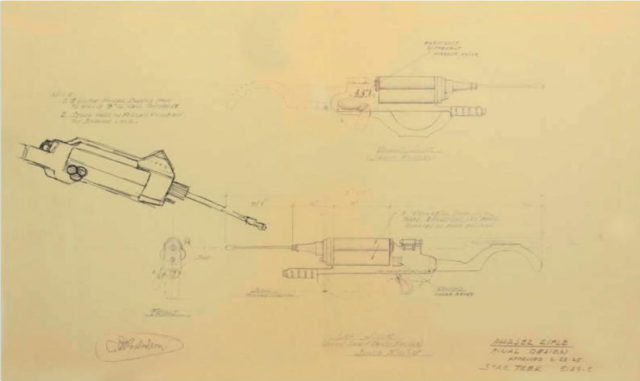
Klamer’s original sketch for the phaser rifle. At this stage, the design included a shoulder brace, which wasn’t part of the final prop. When it wasn’t in use, it swung under the main body. Even in 1965, Roddenberry was interested in merchandise rights and hoped the rifle would become a toy. (Star Trek – A Celebration)
Available today
The 256-page Star Trek – A Celebration was released in hardcover on September 21, and is priced at $34.95 ($44.95 in Canada). You can order it from Amazon.com, or directly from the Eaglemoss Shop.
More from Klamer
As noted above, Reuben Klamer sold the original rifle prop at an auction a decade ago. He appeared in a video ahead of the sale by Julien’s Actions.
Keep up with all the Star Trek books and merchandise news and reviews at TrekMovie.com.
DISCLAIMER: We may link to products to buy on Amazon in our articles; these are customized affiliate links that support TrekMovie by earning a small commission when you purchase through them.

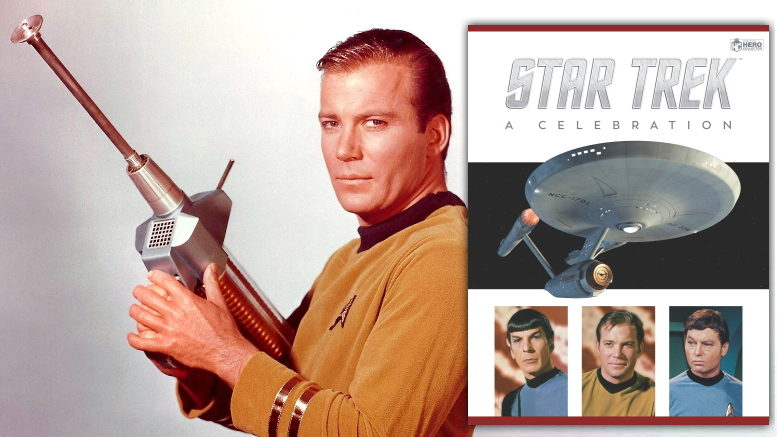
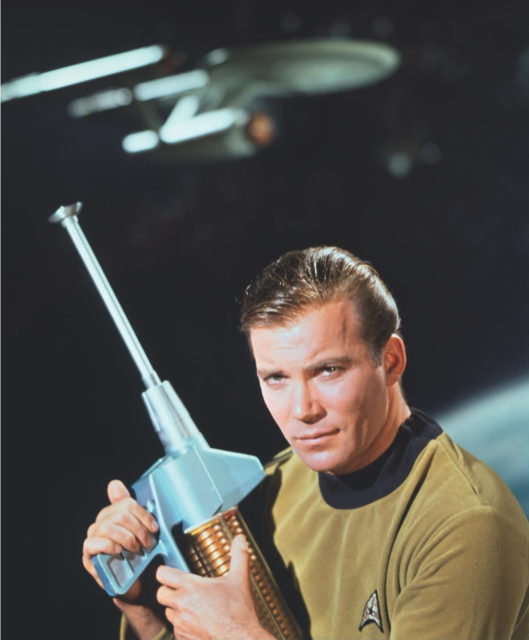
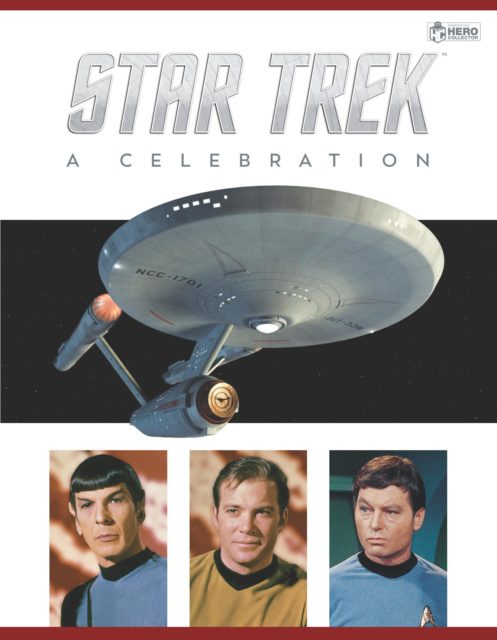
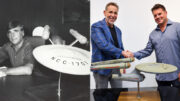

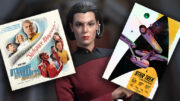
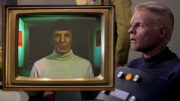
Roddenberry reneged on the original promise of merchandising rights? Gee, what a total shock (sarcasm).
First thought that went through my head, as well. Gee, what a surprise.
Yes, Phil, and let’s not forget, Roddenberry screwed Alexander Courage out of half the royalties on the musical score for the opening credits of TOS, by writing lyrics that nobody ever heard.
To be blunt, Gene Roddenberry could be a real dick sometimes (and that’s the kind word for it).
Sometimes?
Well, A34, I was trying to take the high road. But, hey, you can’t put lipstick on a pig.
I’ll just speak for Roddenberry’s ghost: “You’re welcome, dick.”
I seem to remember Harry Balz commenting that he posted under Michael Hall in the early days here. Care to fess up, Michael / Harry Balz? BTW, I like to agree with myself, too. haha.
Anthony, I have never posted under the name Michael Hall. Interestingly, my first name IS Michael. The only other name I used a few times (years ago) was Holden McGroin. It has a nice ring to it, no?
Nope, sorry. ‘Michael Hall,’ for better or worse, is the name my parents gifted me 63 years ago, and I’ve never posted anything under an alias. As for ‘Harry Ballz,’ I’ll freely admit that there was a time in my life when I would have considered that high wit. Like, when I was in the fourth grade.
Michael, I decided on “Harry Ballz” so it would prove easy to remember, like those cheesy radio ads with a corny jingle. Stupid, but they stick in your head. Corny is hard to forget. :>)
Well, if you’re looking for a memorable handle I’m certainly willing to make some suggestions.
Why not? lol
It’s common practice in the industry. BTW, Courage (and the succeeding generations of his family) has gotten rich off of it and made far more than you’ll see in many lifetimes (unless your ingenious Trek script ever gets produced). harhar.
I can see why the alternative title “Gene Roddenberry: A Celebration” was quickly shot down.
That phaser rifle looks more realistic than the plastic looking toys from TNG.
The TOS weapons props always looked like they had a little heft to them, which you’d expect knowing they had power packs. A lot of the TNG asethetic was plastic, though. That’s been a nit pick for Iron Man and War Machine – they fly in with the fairly form fitting suits, and, Oh! Look! Missiles! Machine guns! Where do you supposed that ordinance was stored in those armor suits?
You’re not supposed to as such questions. What about Hawkeye or Legolas… Did you ever see them run out of arrows?
Never have I ever…..
On the contrary, TOS had the ugliest, most poorly designed props in the franchise. Difficult to take the show seriously when they were so cheap looking. Twilight Zone worked because the episodes were short, and props rarely carried over; not enough time to really focus on the cheap sets and props.
I vehemently disagree.Other than the “white sound device” — a microphone — I’ve always loved TOS’s hand props.
And it sure looks like some folks took TOS seriously, or else we wouldn’t be here talking about this 55 years later.
Props having little to nothing to do with whether or not a series works. Twilight Zone worked because of the writing and Serling’s unique presence. TOS worked because of the actors, the characters, and the camaraderie between them. That’s why we’re still talking about them today.
All I can say, as a kid who watched TOS on re-runs on WPIX 11 out of New York is, it was the TOS props that captivated me. I made my own communicator and phaser out of cardboard and aluminum foil, and sewed velcro to an elastic belt so I could go out in the woods, stand stock still, and “beam” down as part of a landing party to have adventures. On the shelf next to me in my office, I have a TOS Communicator on a stand as one of my most prized collectibles.
So, that’s a contrasting opinion.
They look cheap because they were never intended to be seen in HD. They looked just fine on broadcast TV of the day (and were not in fact cheap, BTW).
Roddenberry was a greedy, insecure creep. He screwed so many people out of money, agreements and credit on Trek. Including David Gerold on his basically co-creating TNG. It’s all well documented how he cheated various people over the years. It doesn’t get much focus because the studio has an interest in pushing this “visionary” myth and we fans play into it as well. I love Star Trek. I don’t drink the kool-aid with the whole Roddenberry-could-do-no-wrong silliness. Glad this guy made his chunk of change when this sold at auction after Roddenberry stiffed him.
Agreed Luke M. The more I read about this guy, the more it’s quite clear he was a major a$$ho.. The fact he was a womanizer and cheated on his wife doesn’t help either. I’m not even convinced he’s responsible for most of what Star Trek turned out to be.
Like George Lucas, Stan Lee or Bob Kane, it was the people around him who took his kernal of an idea and made it great. It was people like Lawrence Kasdan, Irvin Kirschner, Marcia Lucas; Bill Finger and Dick Sprang; Steve Ditko and Jack Kirby– and in this case Gene Koon, Dorothy Fontana, Bob Justman, David Gerrold– who gave Trek its enduring flame, from Roddenberry’s single spark.
It’s been well understood for decades that people like Dorothy Fontana, Gene Coon, and Bob Justman contributed enormously to the success of TOS. But even putting aside the fact that Gene Roddenberry personally hired all of them, if you think that he had nothing to do with Trek’s level of quality you either know nothing of the history of its production, have understood nothing of what you’ve read, or do know and out of spite simply don’t care.
Agreed. People talk about “Gene’s Vision” well, his vision was making money and bedding women!
“You wanna know what my vision is? …Dollar signs! Money! I didn’t build this ship to usher in a new era for humanity. … I built this ship so that I could retire to some tropical island filled with …naked women. That’s Zefram Cochrane. That’s his vision. This other guy you keep talking about. This historical figure. I never met him. I can’t imagine I ever will.”
I always thought Zefram Cochrane’s speech to Riker in “First Contact” was Ron Moore and Brannon Braga talking about Gene Roddenberry. Have they ever confirmed that?
“I always thought,” based on what? Your magical ability to divine authorial intent from moonbeams and starshine? I spoke with Ron Moore at Michael Piller’s memorial service, and while he said he didn’t get to know Roddenberry all that well as his health was seriously deteriorating by the time Moore was hired, his remarks about the man reflected nothing but fondness and gratitude — not for his job on TNG, but for creating TOS, which Moore genuinely loved.
“I always thought” based on the portrayal of Zefram Cochrane as a flawed visionary, like Roddenberry. Nothing else — and that’s why I presented it as a notion and asked the question, rather than presenting it as fact.
“I always thought” is an assertion, sorry. “I always wondered” is a notion.
It’s really not — in my book “thought” and “notion” are synonyms — but I’m sorry if my suggestion was presented too forcefully for your taste. No offense was intended.
My taste is not the issue. That your “book” is factually incorrect as to what words actually mean is, sorry.
Truth
And what is *your* vision, Garak? Is your lofty goal to be the biggest troll and hater on TrekMovie?
I will never understand how he’s still treated in the media as some god like visionary with a heart of gold when pretty much everyone who has actually worked with him has said the complete opposite? There is nothing wrong with being flawed or not actually living up to the ‘vision’ you spout, but he seem to have hurt and mistreated a lot of people along the way which is what really bothers me about him.
Examples of flawed visionaries abound: Picasso, JD Salinger, Steve Jobs, and Elon Musk, to name a few off the top of my head. And we can definitely add Gene Roddenberry to that list. Still, history is generally going to remember the names on that list for their creations, at best with an asterisk; so it is with Star Trek.
The only halfway decent, measured post to be seen on this entire miserable thread. I’ve read more or less everything that’s been said about Trek’s creator, good and bad. I also saw him at several of the college lectures he gave during the Seventies, and I’ll say this much: for all his supposed avarice and other foibles, he always shared credit for Trek’s success, and readily took responsibility for its flaws. Facing thousands who were there to lionize him and his creation, he always went out of his way to put the show into its proper perspective, informing his audience that the true magic lay within them and their desire for a better future, and not a ‘60s TV space opera. And if he attained a celebrity that he ultimately didn’t wholly merit, at least he tried to use it to bring out the best in people, as opposed to their worst. By today’s wretched standards I find that wholly admirable, and a far better pastime than cynically taking down a long-dead TV producer whose great crime was to give birth to a franchise that’s brought so much hope and joy to so many.
I think it’s the hurtfulness and wide-band exploitive behaviour being winked at that bothers me.
The show was great and so is the legacy, but the man was deeply, deeply flawed.
I don’t think we should be asked to look away from that or speak otherwise.
And that’s why the upcoming biopic makes me very deeply uncomfortable.
@ Luke Montgomery – I guess he was actually ‘The Great Fraud Of The Galaxy’ ;)
Sure, he was a lower-tier Hollywood TV producer trying to make money. I’ve never bought the “Gene’s vision” fan worship, either — but we wouldn’t be here talking about this without him.
Isn’t this what usually happens with people of power though? Usually others do the heavy lifting while the one person takes the credit for everything. Its a stupid system that unfortunately still continues to this day and I believe one of the reasons why division between classes exist as it is.
How do you “know” that David Gerrold co-created TNG? By reading the claims of David Gerrold? Well, I’ve got news for you: I worked with Gerrold a decade ago and it was far from a pleasant experience. He was, in fact, something of an ass. That wasn’t just my opinion, either. But I can see now that he was under a lot of pressure at the time, and that the casual abuse he doled out to people who—unlike him—had traveled thousands of miles to work for free was probably not indicative of his true character. People can be complicated, both good and bad, which is more than you’d guess from reading this absurd pile-on of Gene Roddenberry.
People may be complicated, but much of the promotion of Trek is idealizing Roddenberry in a way that makes many of us long time fans very uncomfortable.
Even when celebrating Nichelle Nichols decision to stay with TOS and provide groundbreaking representation, somehow her public statements that the reason she was leaving was that she “didn’t want to be the other woman to the other woman.”
We’re supposed to ignore the transparent evidence of abuse of power with a “casting coach” that set female actors in an ensemble in competition with one another. What an incredibly toxic environment no matter how important that representation was on screen.
Saying that it was another era, doesn’t seem to cut it when Roddenberry is being lauded for his vision of the future and a civil society where people got along and treated one another well.
I think that the volume of these unleavened lionizations is why it’s coming out on this thread.
I can’t speak for others, but I felt very uneasy about the recent news of a biopic being developed. However, few of us brought up these kinds of egregious behaviours on that thread. There were just some views expressed that it had little likelihood of being balanced by publicly known poor behaviour.
So, I think that this small story has given many of us the push to voice our unease.
Oh, really? I’ve been a card-carrying fan for going on a half-century and never realized that I was expected as such to buy 100% into the infallibility and awesomeness of Eugene Wesley Roddenberry. Guess I never got the memo.
Seriously, and sarcasm aside, this is just ahistorical nonsense. Roddenberry died on October 24, 1991. Barely three years later, Joel Engel’s “Gene Roddenberry: The Myth and the Man Behind Star Trek” was published, the first “tell all” biography showcasing him as a womanizer, substance abuser, glory hound, and all-around guru-hypocrite. The book received a fair amount of attention, including a write-up in Entertainment Weekly, but was fairly low-rent and didn’t get much traction. (Engel went on to perform a similar service to the reputation of Roddenberry’s friend Rod Serling a couple of years later.) In 1996, “Inside Star Trek: the Real Story” by Herb Solow and Bob Justman made its debut, repeating many of the charges in the Engel book while also implying that Solow had virtually co-created the show and that Roddenberry was so addled and unfocused that he could barely utter a coherent sentence in public. This was a much glossier and high-profile effort than Engel’s, written by people who had worked with Roddenberry and knew him intimately. It definitely got the attention of the press and the fanbase, who tend to treat it as gospel to this day. Hell, even the “official” Roddenberry biography, written by David Alexander and published in 1995, didn’t by any means give Roddenberry’s foibles a pass, promising readers on the jacket flap to render a full accounting of the man, “warts and all.” And there it is.
In the years following hundreds of interviews and opinions have been published, televised, and streamed depicting Trek’s creator as way less-than-perfect, while giving people like Dorothy Fontana, Gene Coon, and Robert Justman well-earned credit for their part in the show’s success. So far as I know, no corporate commissar working for Paramount has ever tried suppress them, or even deny their claims on the merits. So if there is any “myth” out there, it’s not that Gene Roddenberry was infallible, but that anyone is trying to depict him as such. That simply hasn’t been true for decades, if it ever was.
As to the historical context of Roddenberry’s treatment of his female employees – well, yes, it does indeed matter, sorry. That the Great Bird was a rampaging sexist by today’s standards and that he abused his authority as such is undeniable. It’s also undeniable that he wrote some of the earliest depictions of women with authority and agency in the history of American television, and that he gave his secretary, D.C. Fontana, a chance to pursue her dream to become one of the first woman writers working in that medium. It should be possible for a thinking person to acknowledge both things, just as it’s possible to give Lincoln credit for freeing the slaves while acknowledging that in the context of 2021 he was an unrepentant racist. Yes, the story of Sherry Jackson, then barely in her twenties, being manhandled by Roddenberry for a “costume fitting” is pretty disgusting. But he wasn’t alone, and even Jackson laughs these days when recounting the incident. It was indeed a different era then.
And one other thing: about Nichelle Nichols. While it’s common knowledge that she and Roddenberry conducted an affair during the filming of “The Lieutenant” — lucky him — there’s no indication that she wanted to leave Trek in its second year because of any pressure on his part to continue it. Her issue with her role on the show was that she felt she was being under-utilized, and thought that playing the role of the secretary on “Mannix” would be a better career opportunity. (Martin Luther King famously talked her out of that, and Roddenberry had no interest in letting her out of her contract in any case.) Many years later, she wrote and recorded a very nice song called “Gene” after his death, which she performed for convention audiences all over the country. You really think she would have done that if she’d been sexually harassed?
And you’re a jealous little man who has likely contributed nothing of value to this world. So why should I consider your opinion of a great man who contributed much to the world?
Ray line did produce the tracer rifle, which looked nothing like this prop. Always liked the rifle, though it doesn’t “match” the phaser twos — which is ok. Remco could have just added some stickers to their Monkey division motorized gun, which they did for Voyage to the Bottom of the Sea, and called it a Star Trek rifle.
Certainly enjoyable to find out some heretofore not known TOS trivia (for good or bad) :) .
What is always sad to me is to know that, once again due to these types of auctions, that some affluent fan out there has yet another classic prop stowed away somewhere where it can’t and won’t be seen by anyone else (except presumably his/her friends and family).
Really wish stuff like this would be kept by a museum so it could be seen, even if only from time to time.
I remember reading an interview with Gene Rodenberry in a fan magazine in the 1960s where Gene states that he decided not to use the rifle again because it didn’t fit in with the image he wanted to portray in the Star Trek Universe.
Hmmm. Those early Phaser 1s didn’t look like guns. And wasn’t that why TNG’s phasers didn’t look like guns either? Because Gene didn’t want Starfleet carrying guns around?
I think it would have been a very different show if landing parties had been carrying that phaser rifle. That’s not a defensive weapon. Also, it’s always just looked fake/cheesy/Forbidden Planet-y to me.
Yeah, I know that the network was sold on the “wagon train to the stars” theme and I am sure they loved the idea of the phaser rifle, but I am not surprised that after it helped sell the series that it got tossed aside in favour of phaser one and two.
As for Gene, we all have flaws with virtually none of us being purely good or evil. He certainly had a vision for Star Trek and the future he wanted to portray on screen and for most of that, we are thankful. That said, it is foolish to believe that he was a man without flaws, that he didn’t ever mistreat anyone or that EVERYTHING he wanted portrayed in Star Trek was something to be totally revered.
Wow. This is the first I have heard of Reuben Klamer creating the phaser rifle. I assumed it was Matt Jefferies or maybe Wah Chang. Awesome!
Has anyone else seen the book yet? Do you recommend buying?
Why all the publicity for this book while other non-fiction books are totally ignored here?
I’ve always thought the original rifle looked incredibly awkward to hold and use, zero ergonomics compared to most of the other phaser rifles – except perhaps the ugly ‘tuning fork’ thing that Voyager had. Janeway had the ‘First Contact’ rifle in one episode a not too much later they’re hefting that ugly lump around.
The rifle was used against Mitchell in an attempt to destroy him, not weaken him. It had no effect either way on him.
Perhaps not directly, but it did fell half a mountain on top of Mitchell which contributed significantly to his ultimate demise.